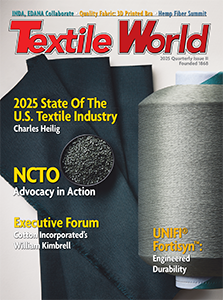Lansing, Mich.-based Kraig Biocraft Laboratories Inc. recently announced it has succeeded in
producing genetically engineered spider silk in a scalable and cost-effective platform. Working
together, researchers from the University of Notre Dame and the University of Wyoming, and Kraig
Biocraft have genetically engineered (recombinant) transgenic silkworms capable of producing
artificial spider silk. The fiber has the desired properties of natural spider silk including high
tensile strength, elasticity and flexibility, making it suitable for a variety of biomedical and
technical textiles end-uses such as fine suture materials, wound-healing bandages, bulletproof
vests and automobile airbags.
“This research represents a breakthrough in the development of superior silk fibers for both
medical and non-medical applications,” said Malcolm J. Fraser Jr., professor, Notre Dame. “The
generation of silk fibers having the properties of spider silks has been one of the important goals
in materials science.”
Fraser owns the patent for “piggyBac,” a unique genetic engineering tool comprised of a piece
of DNA called a transposon that can be inserted into the genetic machinery of a cell. Kraig
Biocraft worked with Fraser, University of Wyoming researcher Randy Lewis, and molecular geneticist
Don Jarvis to develop the transgenic silkworms.
The group reports that the silkworms offer a commercially viable large-scale production
platform for engineered protein fibers. “Using this entirely unique approach, we have confirmed
that transgenic silkworms can be a potentially viable commercial platform for production of
genetically engineered silk proteins having customizable properties of strength and elasticity,”
Fraser said. “We may even be able to genetically engineer fibers that exceed the remarkable
properties of native spider silk.”
Working with leading laboratories and researchers, Kraig Biocraft is now synthesizing DNA
sequences and genetic constructs for its second generation of advanced spider silk-based polymers.
“These new designer DNA sequences are being rolled out as a part of our plan to build on our
recent success by creating new materials and new products,” said Kim Thompson, CEO, Kraig Biocraft.
“These new genetic constructs are being created right now, for use in the production of a new class
of high-performance fibers. We are developing this next generation of genetically modified silk
fibers specifically to capture a share of the technical textiles market. This is the primary market
for high strength fibers and is currently estimated at $120 billion. We believe that these
revolutionary materials will have tremendous potential in the technical textiles marketplace for
high strength fibers.”
November 2, 2010




